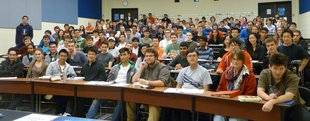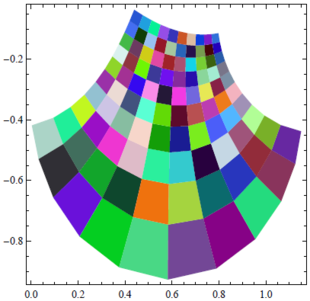12-240/Classnotes for Thursday November 8: Difference between revisions
From Drorbn
Jump to navigationJump to search
No edit summary |
No edit summary |
||
| (3 intermediate revisions by 2 users not shown) | |||
| Line 1: | Line 1: | ||
| ⚫ | |||
{{12-240/Navigation}} |
{{12-240/Navigation}} |
||
== Riddle Along == |
|||
Four cars drive in the Sahara desert at constant speeds and with constant directions. A meets B, C, D; B meets C, D. Do C and D meet? |
|||
== Goals == |
|||
1. compute Rank T over A<br> |
|||
2. Compute <math>T^{-1}</math> over <math>A^{-1}</math><br> |
|||
3. Solve systems of linear equations |
|||
== Theorems == |
|||
1. Given V' -> V -> W -> W' (where the linear transformations are Q, T, P respectively)<br> |
|||
such that P and Q are invertible (i.e. Q is surjective and P is injective) |
|||
then rank T = rank PTQ<br> |
|||
<br> |
|||
2. if T: V -> W, V with basis <math>\beta</math> and W with basis <math>\gamma</math> |
|||
rank <math>[T]_\beta^\gamma</math> = rank T<br> |
|||
<br> |
|||
3. if P and Q are invertible matrices, A is some other matrix, rank A = rank PAQ |
|||
== Definitions == |
|||
if A = <math>M_(m \times n)</math>, then it is linear transformation <math>T_A : F^n -> F^m</math> |
|||
| ⚫ | |||
<gallery> |
<gallery> |
||
Image:12-240 Nov 8 Page |
Image:12-240 Nov 8 Page 1.jpg|Page 1 |
||
Image:12-240 Nov 8 Page 2.jpg|Page 2 |
Image:12-240 Nov 8 Page 2.jpg|Page 2 |
||
Latest revision as of 02:15, 4 December 2012
| |||||||||||||||||||||||||||||||||||||||||||||||||||||||||
Riddle Along
Four cars drive in the Sahara desert at constant speeds and with constant directions. A meets B, C, D; B meets C, D. Do C and D meet?
Goals
1. compute Rank T over A
2. Compute over
3. Solve systems of linear equations
Theorems
1. Given V' -> V -> W -> W' (where the linear transformations are Q, T, P respectively)
such that P and Q are invertible (i.e. Q is surjective and P is injective)
then rank T = rank PTQ
2. if T: V -> W, V with basis and W with basis
rank = rank T
3. if P and Q are invertible matrices, A is some other matrix, rank A = rank PAQ
Definitions
if A = , then it is linear transformation






![{\displaystyle [T]_{\beta }^{\gamma }}](https://wikimedia.org/api/rest_v1/media/math/render/svg/14995a25c99e74f4192a7761e965960c1cc50819)



